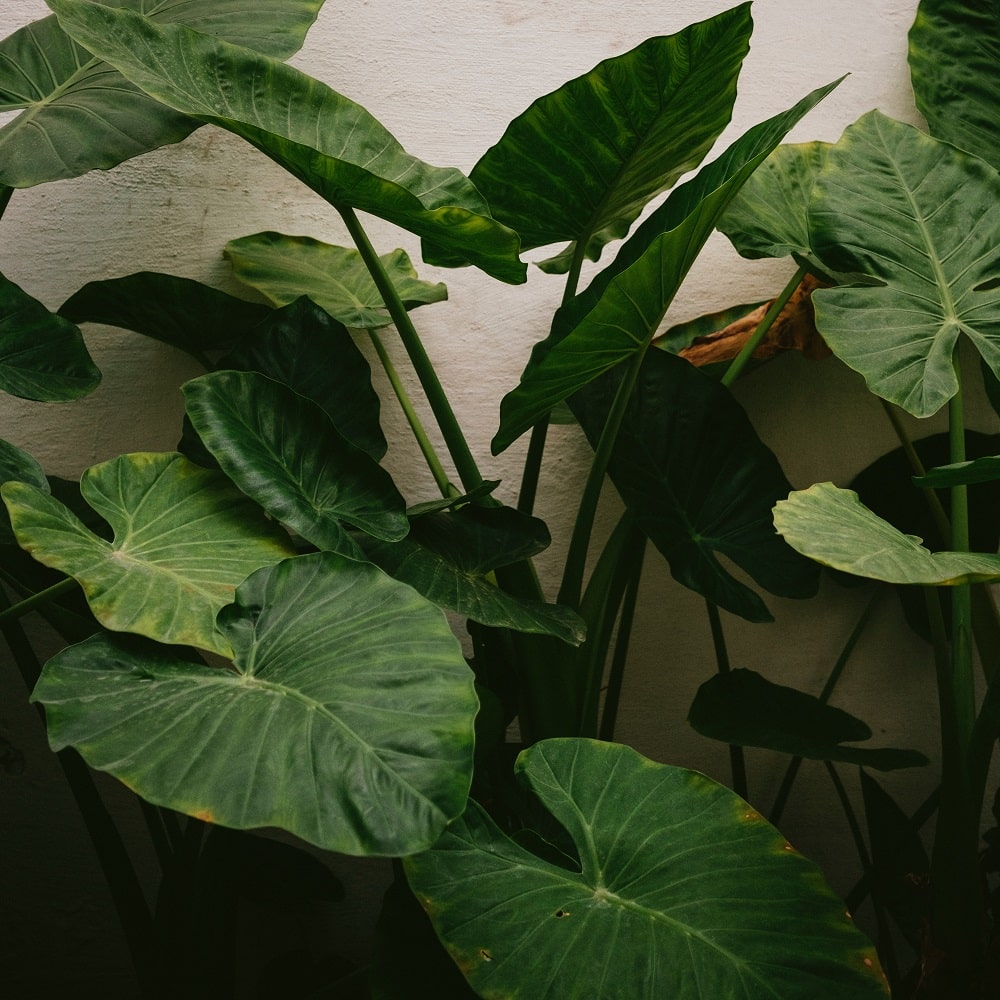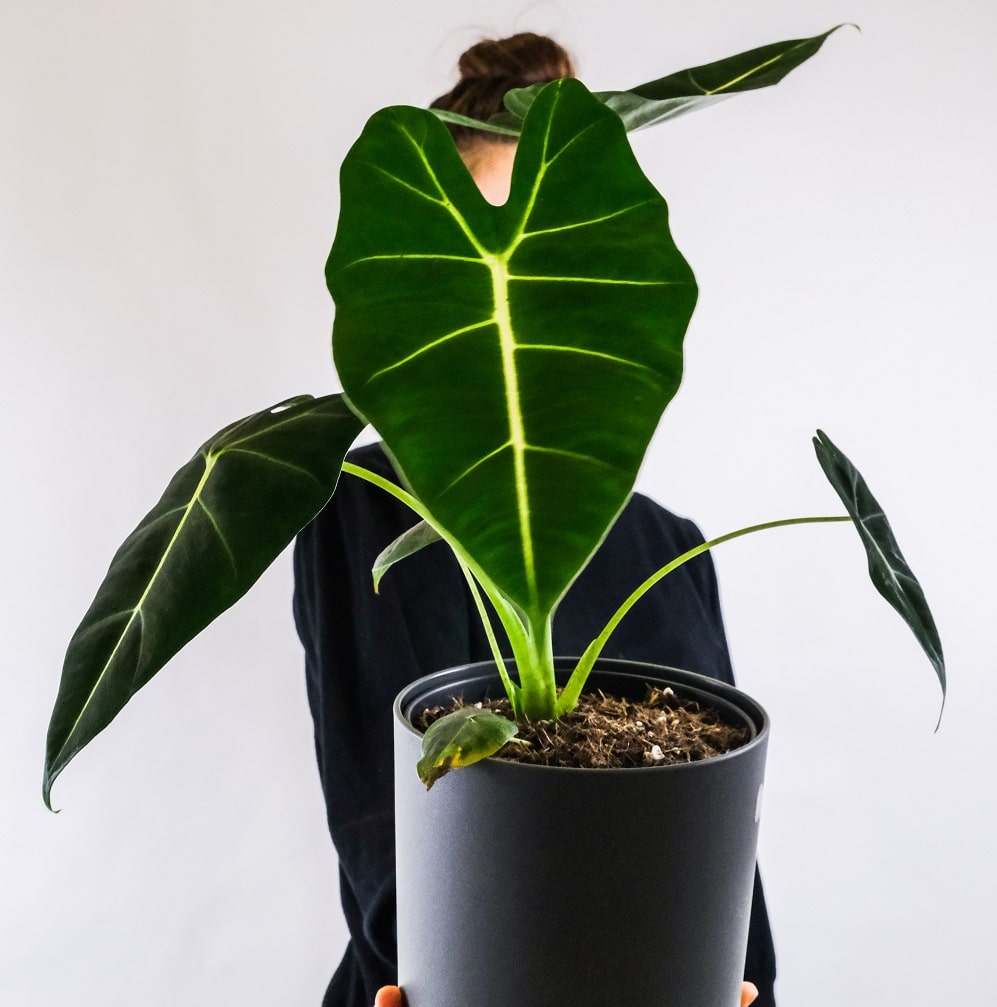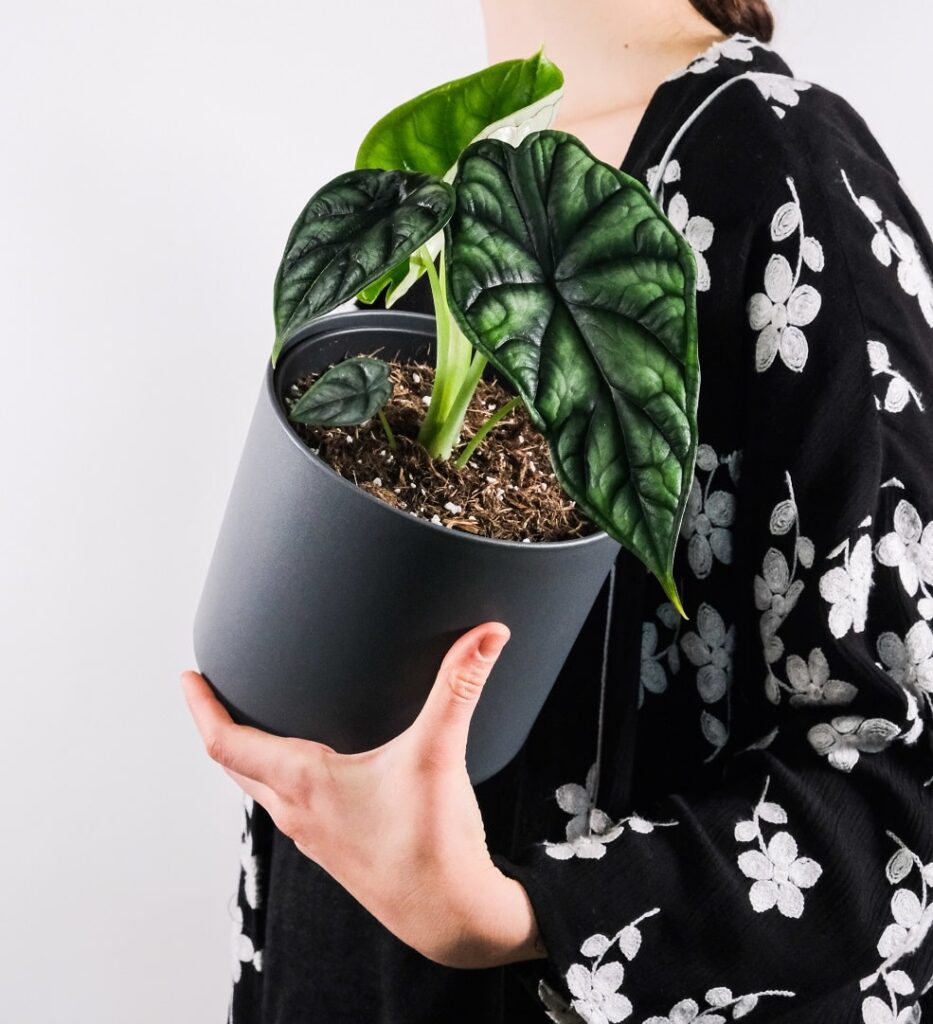Alocasia is the most common houseplant in the world. The plant brings a tropical vibe to the heart of a garden or a room. Thanks to the large shiny leaves display.
Growing and caring for alocasia plants can be challenging. Many gardeners usually battle with alocasia leaf drooping and curling throughout the year.
It would be best to find out the cause of alocasia leaves curling before treating the problem. Most of these issues are super easy to handle and fix.
So, why is my alocasia leaves curling? The possible causes are low humidity, underwatering, nutrient deficiency, low lighting condition, temperature stress, pests, and diseases.
This article provides a detailed explanation of these causes and how to fix them. Take the time to read through it to grow a healthy alocasia plant in the long run.
You Can Also Read: Why Is My Alocasia Polly Turning Yellow?

Causes of Alocasia Leaves Curling and their Solutions
Underwatering Stress
Alocasia plants are tropical plants and need plenty of moisture to survive. Proper watering and moisture regulation are vital parts of alocasia plant care routines.
Most gardeners have busy schedules with their day jobs. Some end up forgetting to water their houseplants, and this leads to leaves curling or drooping.
If you notice your alocasia leaves curling, it could be due to underwatering issue. Failure to resolve the issue, your favorite plant will develop crispy leaves and die.
The best option is to often check the moisture content in the plant pot. Insert your index finger in the potting mix and determine the soil moisture level.
Water the plant and put it in the sink to drain excess water. Too much moisture will cause root rot, and the alocasia leaves will turn yellow in the long run.
Use a moisture meter to track the soil moisture content of your houseplant. Remember to water the plant once a week to foster good health and growth.
Water the alocasia plant less often in winter and regularly in summer. Plant growth is dormant in winter and will require less water.
Over-Fertilization
Growing alocasia plants in containers will need fertilizer. Fertilization helps the houseplant to thrive and grow to its full potential.
But alocasia plants are not heavy feeders like other houseplants. It would be best to play safe to avoid over-fertilization.
Too much fertilizer in the pot will burn the root systems. The alocasia leaf drooping and curling happens to be the initial signs of over-fertilization.
Excess salt buildup around the roots damages the leaf cells and causes curling. You will also notice alocasia crispy leaves.
I recommend feeding your alocasia plant once or twice a month during the growing season. The houseplant is usually dormant in winter and will not utilize the nutrients after fertilization.
Use water-soluble fertilizer during summer and spring for your alocasia plants. The nutrients will make your houseplant develop large shiny foliage.
If you happen to have over-fed your houseplant, consider flushing the soil with plenty of distilled water. You can also re-pot the plant to avoid further leaf problems.
You May Also Enjoy: Why Is My Alocasia Polly Dying?
Pest Infestations
All indoor plants are susceptible to insect infestations. These insects are annoying and inevitable regardless of taking the required measurements.
Alocasia plants are prone to spider mites and mealybugs. These insects cause a lot of leaf problems if not fixed on time.
These pests pierce the alocasia leaves to suck vital juices and damage the cells. The leaves will begin to curl and droop.
I recommend using horticulture soap to eliminate these insects on the leaves. But you will be required to inspect and examine the alocasia foliage more often to detect insect infestations.
Remember to clean alocasia leaves to remove dust that attracts insects. You can use neem oil to remove mealybugs and prevent them from damaging the shiny foliages.
Nutritional Deficiency
An alocasia plant thrives in soil rich in potassium minerals. These nutrients allow the plant to develop large and shiny leaves.
If your alocasia is displaying curling leaves, it is due to potassium deficiency. But there is no need to worry since the issue can be fixed with ease.
Keep in mind that the potassium deficiency effect usually affects the lower and older leaves. If the entire plant leaves are curling, consider undertaking further investigations.
Use water-soluble potassium fertilizer to fix alocasia leaves curling and drooping. Remember to apply potassium fertilizer during spring and summer only.
The best potassium fertilizers for alocasia plants are potassium chloride, potassium nitrate, potassium sulfate, and monopotassium phosphate.
Temperature Stress
Alocasia plants prefer a temperature range of 68-85oF. The temperature range enables the plant to display large and shiny leaves.
Alocasia is a tropical plant and cannot tolerate cold or hot temperatures. If you live in a hot or cold area, alocasia leaves curling will be the order of the day.
The best option is to provide temperature ranges that mimic their tropical habitat. Keep the houseplant away from cold drafts and heaters to avoid leaf curling.
You May Also Enjoy: Why Are My Alocasia Leaves Turning Brown?
Overwatering Issue
Overwatering is the leading cause of alocasia leaves curling and turning yellow. These houseplants love high moisture content. But a wet environment can be harmful to the houseplant.
Damp soil causes root rot, and this disease hinders the root functions. The plant leaves will start to curl, droop, and even develop brown spots.
Overwatering occurs due to improper drainage. I recommend using a pot with drainage holes at the bottom. It will help to get rid of excess water to prevent root rot.
Re-pot the houseplant to a new container with fresh potting soil. Cut off the damaged leaves and roots using sterilized scissors.
Water Quality
Water quality is a crucial factor when it comes to alocasia plant care. Tap water contains chemical compounds that are harmful to the alocasia leaves.
If your houseplant leaves are curling, it could be due to the use of tap water. The water contains a lot of minerals and salts that build up around the root systems.
Too many minerals inhibit the roots from absorbing water, and this causes leaf curling problems. Use distilled or filtered water to fix alocasia leaves from curling and drooping.
You can also use rainwater as an alternative to distilled water. It is affordable and will give the best result when compared to distilled water.
You May Also Enjoy: Why Is My Alocasia Zebrina Drooping?
Extreme Sunlight Exposure
Alocasia plants thrive under the canopy in their natural habitat. The plant receives scattered sunlight to facilitate photosynthesis and other physiological processes.
Alocasia leaves curling could be due to direct exposure to sunlight. The excess lighting condition creates energy that the foliage cannot handle.
Besides that, too little light can make alocasia leaves curl. It happens since the plant is unable to undertake vital physiological processes.
I recommend putting the plant in a place where it receives bright indirect sunlight for 6-8 hours every day. It will help the plant develop beautiful and healthy green leaves.
Low Humidity
All tropical plants love high humidity levels to thrive. Alocasia plant is not an exemption. But many houseplant enthusiasts find it challenging to maintain high humidity in winter.
Low humidity makes alocasia plants lose more water. The absence of water in the plant cells could be responsible for curling and drooping leaves.
Misting the alocasia leaves helps to increase the humidity level. The technique will prevent your alocasia leaves from curling and drooping.
Another excellent option is to install a humidifier in the house. It will keep the air moist in winter and prevent the alocasia leaves from curling.
Remember to keep your houseplant away from air conditioners and radiators to give it adequate moisture. Heaters or radiators usually cause alocasia crispy leaves.

Pot Size
Alocasia plants are not root-bound plants. These plants love to grow in an area that allows the roots to spread out.
If you notice alocasia leaves curling, it could be due to the small pot size. The roots become densely packed and entangled to limit water absorption.
I recommend growing the houseplant in a larger pot to prevent alocasia leaf drooping and curling. The environment makes your alocasia look happy and healthy.
Frequently Asked Questions
Why Is My Alocasia Drooping Leaves?
The main causes are overwatering and under-watering issues. Other possible reasons are lighting problems, low humidity, temperature stress, and pest infestations.
Why Is My Alocasia Leaf not unfurling?
Low humidity is the most common cause of delayed leaf unfurling. Insect infestation is a minor cause of alocasia leaf not unfurling. Increase humidity and get rid of pests to foster leaf unfurling on your houseplant.
Why Are My Alocasia Leaves Turning Brown?
Possible causes are improper watering schedule, direct sunlight exposure, low humidity, and more. The best option is to identify the cause and fix it.
Why Are My Alocasia Leaves Turning Yellow?
The most common cause of yellowing of leaves among alocasia plants is an overwatering issue. Other possible causes are low lighting conditions, old age, pests, and diseases.
Why Is My Black Velvet Alocasia Curling under?
Inappropriate black velvet alocasia plant care is the reason for curling leaves. Other causes are improper watering routine, low light, potassium deficiency, pests, and low humidity.
Why Are My Alocasia Zebrina Leaves Curling Down?
Alocasia zebrina leaves curling down are due to overwatering, under-watering, pot size, low humidity, and more.
You Might Also Like: 20 Beautiful Alocasia Varieties with Names and Pictures

Final Thoughts
Alocasia leaves curling could be due to several factors. The rule of thumb is to identify the cause and try to fix it. Each cause is fixed uniquely.
Low humidity, potassium deficiency, and inappropriate lighting conditions happen to be the main cause of alocasia leave curling and drooping.
Providing a perfect growing condition for alocasia plants will result in large and shiny leaves. Give the plant adequate water, nutrients, light, and recommended temperature range to enjoy the beautiful foliage.
You Can Also Read: Why Are My Hoya Leaves Curling?
More Sources and References
- Editor. Elephant Ear Leaves Curling. Houzz.
- Alex. The Plant Whisperer. Grow Well.
- Editor. Alocasia Plant Care. UK Houseplants.